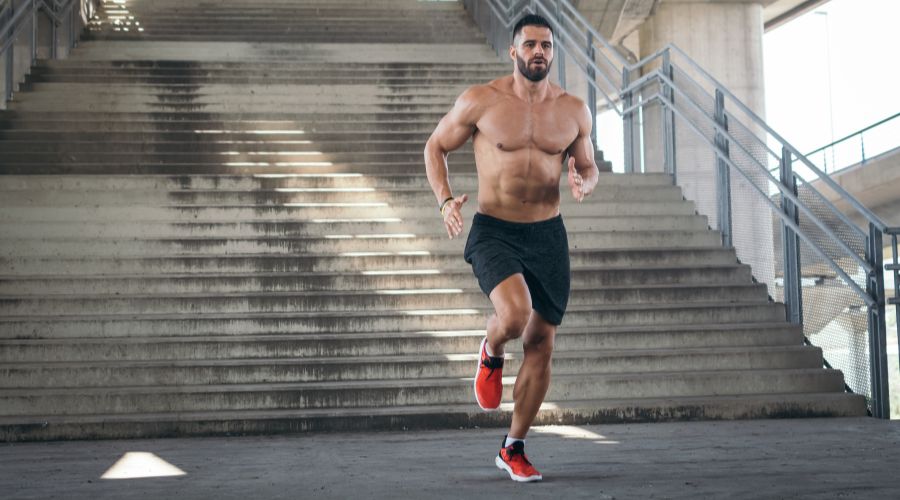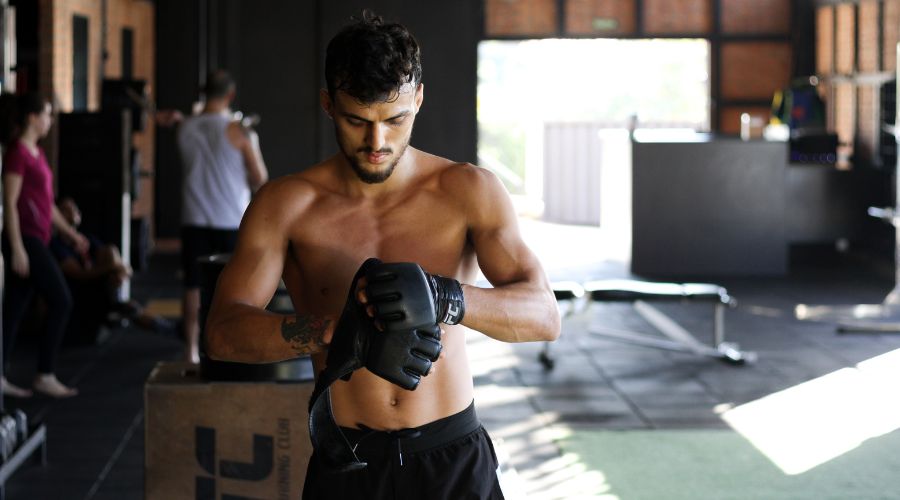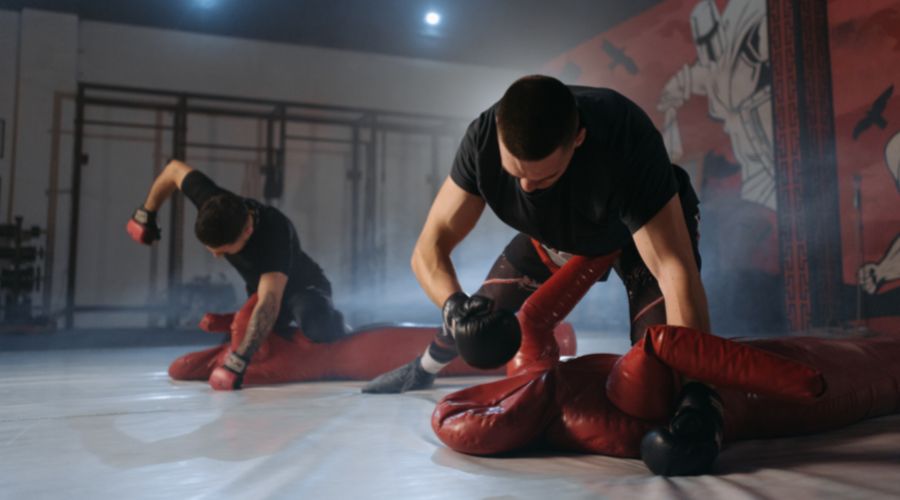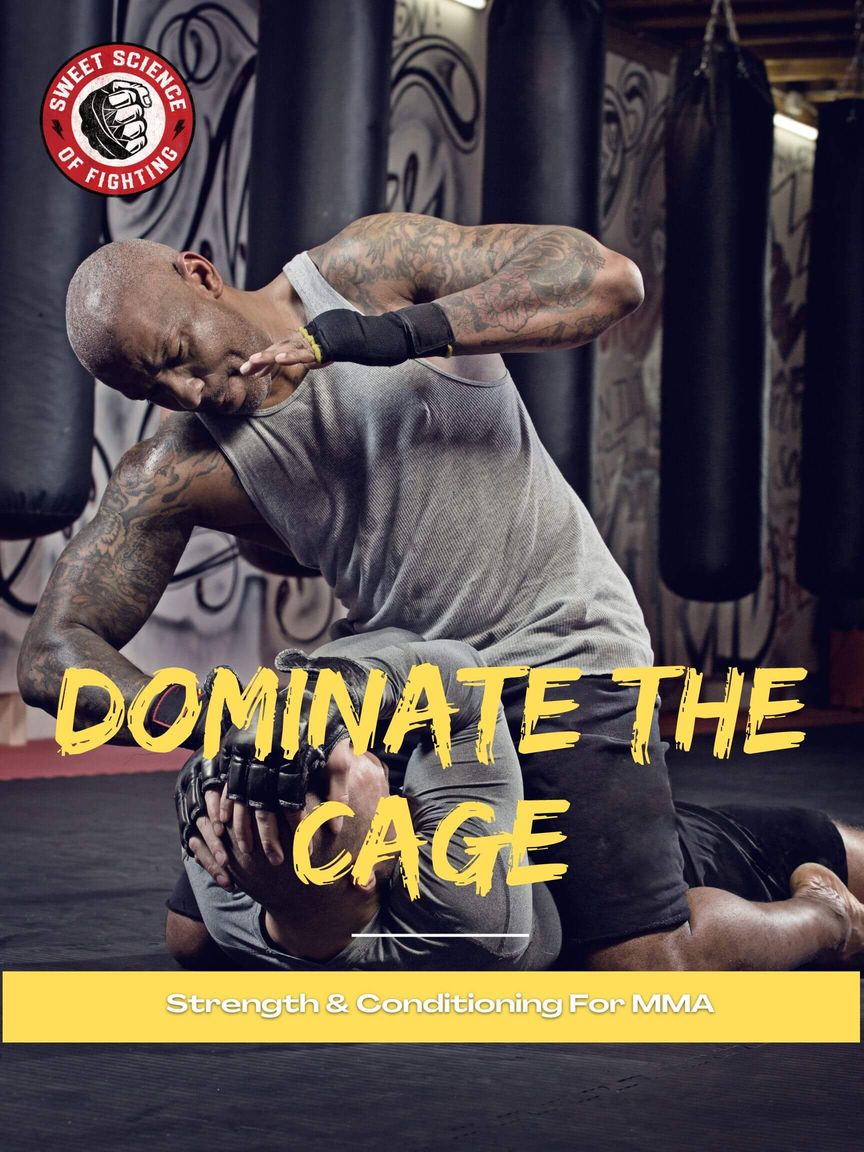If you’re on this site or part of our community, then you're likely interested in how to maximize the fitness and performance of either yourself or other combat sports athletes. This is good.
It's what we should be doing as practitioners or athletes. As a general rule of thumb, it would also help if the training methods used minimized disruption to technical/tactical training or, better still, complemented it.
This becomes a vital aspect of training prescription and organization in a sport where the technical/tactical elements are essential and widely varied (such as MMA).
As such, there is a great deal of interest in using high-intensity interval training (HIIT) amongst MMA athletes and coaches to improve fighters' fitness in a time-efficient and effective manner. So, let's look at what HIIT is, how you can use it, and whether it is the best option for MMA fighters.
What Is HIIT?
Successful adaptations to training and exercise largely depend on the exercise being completed at the required intensity for the necessary duration. This is because training adaptations are dose-dependent.
In simplest terms, if an athlete experiences a large enough disruption to their physiological homeostasis, their body will adapt relative to that disruption. If the disruption is minor, adaptations will be small or not occur.
If the disruption is the appropriate size or duration, then the resulting adaptation will be large enough to cause an improvement in physiological performance [1].
Traditionally, adaptations to cardiorespiratory performance have been achieved by athletes completing moderate-intensity continuous training (MICT), such as medium-long distance jogging at an intensity up to 70% of their V̇O2max for up to an hour. Think of the common conception of a boxer getting up at 4:00 am to do road work.

How to Dominate Every Fight with Raw, Explosive Power No One Can Match
Discover the underground blueprint that has quietly turned MMA hopefuls into legends, using nothing but sheer, brute force and bulletproof conditioning techniques.
The physiological disruption this causes is a reduction in available glycogen, an increase in cellular carbon dioxide (CO2), a reduction in available adenosine triphosphate (ATP) for muscular contraction, and a prolonged strain on the myocardium (the muscle that makes up the heart).
The body responds by increasing the number and size of hemoglobin within the muscle to improve the efficiency of glycogen and fat use during exercise. This increases the number of capillaries to enable greater CO2 clearance; increasing the size of the heart increases stroke volume and oxygen (O2) delivery to the muscles [1].
The overall effect is an improved V̇O2max and better cardiorespiratory endurance. The problem is that this type of training takes a long time and does not provide the muscular force adaptations needed for a high-impulse event such as MMA.
To achieve these same results from shorter durations while also attaining muscular adaptations, coaches and athletes started experimenting with HIIT.
HIIT is a training method designed to provide the physiological disruptions discussed above but with a much shorter training duration.
When completing a HIIT training session, you are required to work at a higher intensity than during MICT training but in multiple short-duration blocks with a recovery period between each.
In theory, the high-intensity work periods provide a significant enough stimulus to cause adaptations. While splitting the training with recovery periods avoids failing to complete the session due to muscular fatigue.
This structure is proposed to allow you to spend more training time at or close to your V̇O2max (T@V̇O2max), thus maximizing adaptations. To make this achievable in practice, it is recommended to test velocity (speed) at V̇O2max (vV̇O2max) and base the work period intensities on % of this velocity [2].
Finding this speed can be done either by completing a lab-based V̇O2max test or by calculating the athlete’s maximal aerobic speed (MAS) either through a short, mode-specific test [3] or by using the running based 30-15 test [4].
Several forms of HIIT have been developed. The table below briefly summarizes the most prevalent ones currently discussed in research and their proposed physiological targets.
HIIT Type | Work Periods | Work Intensity | Recovery Periods | Recovery Intensity | Physiological Targets |
|---|---|---|---|---|---|
Long HIIT | 2-8 x 2-8 mins | 90-100% vV̇O2max | 1-3 mins | Passive | More central than peripheral: CO2 production; glycogen reduction, ATP reduction; ADP increase; myocardial strain. |
Short HIIT | 8-10 x 10-60 s | 100 – 120% vV̇O2max | 10-60s | Passive – 60% vV̇O2max | More central than peripheral: CO2 production; glycogen reduction, ATP reduction; ADP increase; myocardial strain; increased muscle acidosis; neuromuscular strain |
RST | 3-6 x 3-10s x 3-6 blocks | All out | 15-60s between sets, 2-4 mins between blocks | Passive – 60% vV̇O2max | More peripheral than central: ATP reduction; ADP increase; increased muscle acidosis; increased muscle buffering; neuromuscular strain. |
SIT | 4-6 x 20-30s | All out | 1-4 mins | Passive | Peripheral: ATP reduction; ADP increase; increased muscle acidosis; increased muscle buffering; neuromuscular strain. |
RST = repeat sprint training; SIT = sprint interval training; central = cardiorespiratory adaptations; peripheral = muscular adaptations. | |||||
Do MMA Fighters Do HIIT?

This is where things are tricky from a data standpoint. Anecdotally, yes, we know that some MMA fighters are using HIIT in their training. Some literature provides recommendations on how this might be incorporated [5].
Whether these methods are effective or not, or if they're being used appropriately, is an entirely different discussion (see next section below). Our recent examination of MMA training methods and practices found that very few fighters in our sample participated in any supplementary cardiorespiratory training.
When this type of training was incorporated into technical/tactical sessions, it was done in an ad-hoc fashion and without any measurement of appropriate intensity [6].
However, with the work and advocacy of the UFC Performance Institute [7], it may be the case that effective and targeted HIIT protocols are becoming more widely used among higher-level athletes in the sport.
There are more studies in other combat sports, with these results providing mixed levels of support for HIIT.
A meta-analysis of HIIT in combat sports found improvements in relative V̇O2max in both striking (pooled mean difference = +2.83 ml∙kg∙min-1; +5 ± 3%) and grappling-based sports (pooled mean difference = +2.36 ml∙kg∙min-1; 4 ± 5%) but with improvements of anaerobic capacity (W and W∙kg-1) in grappling sports only [8].
Conversely, a review of HIIT responses in Olympic combat sports athletes found greater increases in relative V̇O2max/peak (+4.2 ± 1.9 ml∙kg∙min-1; 8 ± 5%) but no changes in absolute V̇O2max/peak (0.1 ± 0.1 L∙min-1; 0 ± 3%).
This study did, however, also find HIIT to be related to increased lower body peak power (W and W∙kg-1) and maximal accumulated oxygen deficit (MAOD, ml∙kg-1) in comparison to controls [9].
The results of these two studies indicate that the effects of HIIT on V̇O2max in combat sports may depend on which type of combat sport is being assessed and, crucially, whether reported measures are related to body mass or not.
To date, the only study that provides data on the effects of HIIT on MMA fighters prescribed short HIIT (6 x 60 s rowing ergometer) twice a week and SIT (3 x 6 x 60 m sprinting) once a week for four weeks.
Participants following this protocol experienced a 13.3 ± 14.5% improvement in estimated V̇O2max (pre = 41.5 ± 11.1; post = 46.2 ± 10.3 ml∙kg∙min-1) [10].
This shows promise for this type of protocol. Still, with so little data available on the use of HIIT in MMA, it's difficult to know if this method is widely used or is being used as prescribed. There is also no data comparing HIIT to MICT in this population.
Should MMA Fighters Do HIIT?

Before we get into the positives and negatives of HIIT for MMA, we need to be clear about what the physiological requirements of MMA appear to be. MMA is a sport of repeated, intermittent high-impulse actions over a maximum duration of 15-25 minutes (9 minutes for amateurs).
It causes an average heart rate greater than 90% HRmax between rounds [11] and post-bout lactate = 9-21 mmol∙L-1 [12]. So, we can agree that MMA is a high-intensity sport. It is, however, also an aerobic sport due to the maximum duration of a bout being longer than 2-3 minutes.
Data from other combat sports show quite clearly that 60-70% of the energy used in competition is from aerobic means [13][14][15]. Therefore, MMA may be best categorized as a high-intensity aerobic endurance event where you likely spend most of your time in the aerobic-anaerobic transition zone.
To perform in this zone for 15-25 minutes, a person requires a better than average V̇O2max, a high muscle buffering capacity, and good exercise economy provided by an efficient neuromuscular system [16].
Any training method that does not provide at least one of these physiological adaptations is not worth your time as a fighter. So, the question is: does HIIT provide these?
HIIT has relatively large support in the literature for being more effective at improving V̇O2max than MICT [17][18][19]. This effect has been suggested to be a combination of HIIT allowing a high enough intensity to be achieved while being more enjoyable (less miserable?) than MICT so people will complete the required training frequency.
However, a key obstacle is that many of these studies were conducted using sedentary or untrained people as participants. This is a problem because the lower a person's training status, the lower and less specific the training dose needs to be to cause adaptations.
Recent analyses suggest that active participants with V̇O2max greater than ~50 ml∙kg∙min-1 may respond to HIIT with lower or even negative adaptations in comparison to untrained people [20][21][22]. This is clearly an issue if you have a better-than-average cardiorespiratory system, as there is a possibility you might not get any aerobic benefit from HIIT at all.
Current data shows that MMA fighters may be classified as ‘untrained’ – ‘trained’ from an aerobic standpoint [23], with V̇O2max ranging between 41.5 ± 11.1 – 62.8 ± 4.9 ml∙kg∙min-1 [12]. This highlights the requirement of personalizing the athlete's training and physiological needs. Some fighters may respond positively to HIIT, and some may not.
A distinction also needs to be made between which HIIT types are used. Short HIIT, RST, and SIT may potentially improve MMA conditioning in the short term (3-4 weeks) by improving muscle buffering [24][25] (see peripheral physiological targets in the table).
Enhancements to O2 delivery via improved stroke volume (SV) and, therefore, cardiac output (see central physiological targets in the table) appear to require longer training periods with longer HIIT intervals [17][18][19][22].
Regarding these central adaptations, there is a suggestion that athletes show very little adaptation to short HIIT, RST, and SIT. Their increased movement efficiency brought about by their technical/tactical training may reduce these HIIT types' peripheral physiological strain.
This, in turn, increases the size of the acute stimulus needed to cause chronic adaptations. For athletes in this position, it's been suggested that long HIIT should be their primary focus due to its greater focus on central adaptations [20].
HIIT Workouts For MMA

So, what HIIT workouts might be suitable for MMA fighters? This is where you need to understand your athlete, their training status, and what physiological adaptations they need at this point.
Following traditional strength and conditioning practices of moving from low-intensity work to high-intensity work as competition approaches is likely a safe place to start for most athletes.
Training mode would also need to be considered whether you would complete this work by running outside, on a treadmill, rower, or stationary bike. There is also the option of 'game-based HIIT,' which we'll discuss towards the end of this article.
The following would be general recommendations of when each type of aerobic and HIIT training may be most effective. Please be aware these recommendations are based on the first principles of which physiological adaptations are most likely from these methods and generalized timings of when you would most benefit from each.
Your role is to test your current physiology to determine how closely they fit each recommendation and whether there is time available to achieve adaptations.
Does this training need to be performed by running/cycling/rowing? Well, no, potentially not. Game-based HIIT has become commonplace in ambulatory sports such as association football and hockey.
As the name suggests, this training type allows you to achieve physiological adaptations by completing sport-specific drills in an intermittent manner [5][26][27]. This may well be preferable for MMA fighters due to the range of skills you need to train and the specificity of the actions being performed.
It's vital, however, that the intensity of these sessions - whether they're technical skill-based, circuit-based, or sparring based – are set appropriately. Heart rate monitoring is the most accessible method for most people.
As such, it is possible to take advantage of the relationship between V̇O2max% and heart rate reserve % (HRR%) [28]. For example, suppose you calculate your 95% HHR (see equation below) and ensure that whatever training you are performing, your HR is within a couple of beats of that figure. In that case, you will work close enough to 95% of their V̇O2max.
As such, adequate planning ensures the intensity can be achieved and maintained across a sufficient number of sets. Your MICT, long HIIT, and lower intensity short HIIT sessions can be completed as part of your technical/tactical fight sessions.
SIT, and RST are both ‘all out’ training types, so the volume and recovery periods are of more concern with those training types.
95% HHR = ((max HR – resting HR) * 0.95) + resting HR
Summary
Overall, HIIT methods can be an important tool in the coach’s arsenal. It’s unlikely, however, that they are a magic bullet that can provide everything the athlete needs all at once. It’s vital that training is planned to target the specific physiological adaptation the athlete needs.
We must also remember that these physiological adaptations will differ depending on how far out from competition they are and the athlete’s current physiological capacities.
So, there’s your starting point: measure your athlete’s current physiological status and find the gaps in their current abilities. Chances are that HIIT if used appropriately, will at some point help you plug some of those gaps.
Biggest, Baddest Gas Tank In Just 8 Weeks
Dominate The Cage is specifically designed to develop elite level MMA cardio based on your easy to implement test results


References
1. Viru A, Viru M. Nature of training effects. In: Garrett Jr., William and Kirkendall, Donald, editor. Exercise and Sport Science. Lippincott Williams and Wilkins Philadelphia; 2000. p. 67–95.
2. Buchheit M, Laursen P. Using HIIT Weapns. In: Laursen, Paul and Buchheit, Martin , editor. Science and Application of High-Intensity Interval Training. Human Kinetics; 2019. p. 73–118.
3. Baker D. Recent trends in high-intensity aerobic training for field sports. Professional Strength and Conditioning. 2011;22:3–8.
4. Buchheit M. The 30-15 intermittent fitness test: 10 year review. Myorobie Journal. 2010;1(9):278.
5. French D. Combat Sports. In: Laursen, Paul and Buchheit, Martin, editor. Science and Application of High-Intensity Interval Training. Human Kinetics; 2019. p. 226–45.
6. Kirk C, Langan-Evans C, Clark D, Morton J. Quantification of training load distribution in mixed martial arts athletes: A lack of periodisation and load management. PLoS One. 2021;16(5).
7. UFC. A cross-sectional performance analysis and projection of the UFC athlete: Volume two. 2021.
8. Vasconcelos B, Protzen G, Galliano L, Kirk C, Del Vecchio F. Effects of high-intensity interval training in combat sports: A systematic review with meta-analysis. Journal of Strength & Conditioning Research. 2020;34(3).
9. Franchini E, Cormack S, Takito MY. Effects of High-Intensity Interval Training on Olympic Combat Sports Athletes’ Performance and Physiological Adaptation: A Systematic Review. The Journal of Strength & Conditioning Research. LWW; 2019;33(1):242–52.
10. Kostikiadis IN, Methenitis S, Tsoukos A, Veligekas P, Terzis G, Bogdanis GC. The effect of short-term sport-specific strength and conditioning training on physical fitness of well-trained mixed martial arts athletes. Journal of Sports Science and Medicine. 2018;17(3):348–58.
11. Petersen C, Lindsay A. Movement and physiological demands of amateur mixed martial art fighting. The Journal of Sport and Exercise Science. 2020;4(1).
12. Kirk C, Clark D, Langan-Evans C, Morton J. The physical demands of mixed martial arts: A narrative review using the ARMSS model to provide a hierarchy of evidence. Journal of Sport Sciences. 2020;38(24):2819–41.
13. Doria C, Veicsteinas A, Limonta E, Maggioni MA, Aschieri P, Eusebi F, et al. Energetics of karate (kata and kumite techniques) in top-level athletes. European Journal of Applied Physiology. 2009;107(5):603–10.
14. Campos FAD, Bertuzzi R, Dourado AC, Santos VGF, Franchini E. Energy demands in taekwondo athletes during combat simulation. European Journal of Applied Physiology. 2012;112(4):1221–8.
15. Rodrigues-Krause J, Silveira FP da, Farinha JB, Junior JV, Marini C, Fragoso EB, et al. Cardiorespiratory responses and energy contribution in Brazilian jiu-jitsu exercise sets. International Journal of Performance Analysis in Sport. Taylor \& Francis; 2020;20(6):1092–106.
16. Draper N, Marshall H. High-intensity aerobic endurance sports. In: Draper, Nick and Marshall, Helen, editor. Exercise Physiology for Health and Sports Performance. New York: Routledge; 2013. p. 322 – 350.
17. Bostad W, Valentino SE, McCarthy DG, Richards DL, MacInnis MJ, MacDonald MJ, et al. Twelve weeks of sprint interval training increases peak cardiac output in previously untrained individuals. European Journal of Applied Physiology. 2021;1–10.
18. Wisløff U, Ellingsen O, Kemi OJ. High-intensity interval training to maximize cardiac benefits of exercise training? Exercise and Sport Sciences Reviews. 2009;37(3):139–46.
19. Cox ML, Bennett 3rd J, Dudley GA. Exercise training-induced alterations of cardiac morphology. Journal of Applied Physiology. 1986;61(3):926–31.
20. Wen D, Utesch T, Wu J, Robertson S, Liu J, Hu G, et al. Effects of different protocols of high intensity interval training for VO2max improvements in adults: A meta-analysis of randomised controlled trials. Journal of Science and Medicine in Sport. 2019;22(8):941–7.
21. Milanovic Z, Sporis G, Weston M. Effectiveness of high-intensity interval training (HIT) and continuous endurance training for VO 2max improvements: a systematic review and meta-analysis of controlled trials. Sports Medicine. 2015;45(10):1469–81.
22. Rosenblat M, Granata C, Thomas S. Effect of interval training on the factors influencing maximal oxygen consumption: A systematic review and meta-analysis. Sports Medicine. 2022;1–24.
23. De Pauw K, Roelands B, Cheung SS, De Geus B, Rietjens G, Meeusen R. Guidelines to classify subject groups in sport-science research. Int J Sports Physiol Perform. 2013;8(2):111–22.
24. Jacobs RA, Flück D, Bonne TC, Bürgi S, Christensen PM, Toigo M, et al. Improvements in exercise performance with high-intensity interval training coincide with an increase in skeletal muscle mitochondrial content and function. Journal of Applied Physiology. 2013;
25. Vincent G, Lamon S, Gant N, Vincent P, MacDonald J, Markworth J, et al. Changes in mitochondrial function and mitochondria associated protein expression in response to 2-weeks of high intensity interval training. Frontiers in Physiology. 2015;6:1–8.
26. Amtmann J. High intensity interval training and the mixed martial artist. In: Warnick, Jason and Martin, W, editor. Advancements in the Scientific Study of Combative Sports. Nova Science; 2010. p. 13 – 39.
27. Harvey B. Energy system development in elite mixed martial arts. Journal of Australian Strength and Conditioning. 2018;26(4):75–89.
28. Reuter B, Dawes J. Program design and technique for aerobic endurance training. In: Haff, Gregory and Triplett, Travis, editor. 4th ed. Human Kinetics; 2016. p. 559–604.

